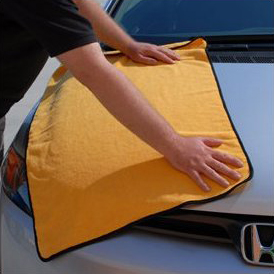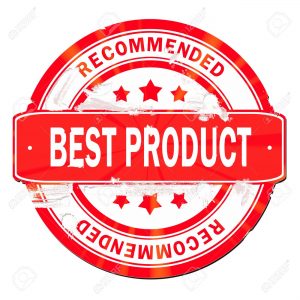The Kevin Brown Method: General overview and recapitulation
Written by: Vinnie van Rooij
When removing paint defects, like scratches or water spot etching, the Kevin Brown Method uses a Finishing Polish instead of the traditional heavy-cut compound. This is done via a combination with a microfiber polishing pad and a random orbital polisher.
We have to note that this method should be used as a backup method NOT as a replacement of the traditional methods. When polishing, be aware that there is a limited amount of paint that can be safely removed from any painted surface. Although we use a finishing polish there is still a vast amount of paint removed during the process.
Contents
Materials
The materials for this procedure are chosen to minimize the negative effect of paint residue accumulation. A finishing polish is used because of the traditional style compounds which deliver a longer buffing cycle. A microfiber pad is used for its good ability in contouring into every corner of the defect. The pad also cuts rapidly, because of the large surface area. Other pads could be used for this procedure, for example foam pads. But the microfiber pad is the most effective in keeping paint residue accumulation to a minimum.
Pad comparison
There are different kind of pads and they all have different types of fabrics, fibers and different stiffness:
- The pad with pores and walls in between them is a foam pad. The walls of this foam can be thin or thick, the total area of the pad is dependent of the thickness. But the contact with the paint is very difficult to measure, especially when we add buffing liquid.
- A wool pad can have rectangular or cylindrical fibers, and we don’t know in which way the fibers will bend while polishing. Surface area decreases when fibers stick together. A knitted wool pad has a great surface area and good contour ability, but has to be cleaned a lot for satisfactory results. A twisted wool pad has less surface area, because of thick strands of wool.
- Another pad with little surface area is the surbuf pad. A problem with this pad is that the microfingers can stick to the paint.
But the finishing polish and the pad can’t be used without a machine on your car. You can use any type of random orbital machine, but the preference goes to a machine that has a larger stroke, one with good motor power and that has enough rotating mass.
Random orbital and the effect on your polishing performance
The different settings of a random orbital can affect your polishing performance. While using a random orbital machine stroke size, speed setting and pressure are variables that should be taking into consideration.
Stroke size
A smaller stroke size will accomplish a refined finish. A stroke machine is great for working on small or confined areas and easy to control. A larger stroke size is better for a consistently levelling of the surface. An disadvantage of a lager stroke size is that this causes more vibration, and this can affect the paint polish.
Speed
For (heavy) defect removal you can use a high or low speed. A high speed gives the benefit of accomplish a lot of cutting in a short period of time. A low speed has some benefits such as a higher level of flexibility or no need to control the machine by a heavy hand.
Pressure
Different factors should be taken into account when applying pressure. For defect removal you should apply a lot of pressure to notice a difference. When you don’t want to use a lot of pressure or can’t press hard enough, you can use a smaller diameter pad or change the stroke diameter.
At this point we have the materials for this method. On to the procedure, because the procedure is a bit different than the usual procedure.
Priming the pad
For this method we use a microfiber pad. The first step is to massage a massive amount of the finishing polish into the pad. It should colour the pad, but not form accumulations of product on the pad. After that, you need to put some finishing polish direct on the surface area, which minimizes the paint residue accumulation and therefore minimizes the negatives effects of the paint accumulation.
Importance of pad priming
Priming your pad is very important, because it slows the absorption of liquid compounds. By priming the pad we create a hard barrier, which keeps the liquid from travelling through the pad. This will prevent pad saturation with paint residue. Depending on your goal you should prime your pad in different ways.
Priming your pad depending on the goal
For defect removal the pad should be manually primed to cover the hole face of the pad. It should cover the pad without any accumulations. This way of priming for defect removal, gives us some benefits:
- The face of the pad becomes more stiff.
- The useable surface area of the pad increases.
- It mass-loads the face of the pad.
For finishing polish we also prime manually, but remove excessive amount of buffing liquid. The best way to remove excessive amount of buffing liquid is to clean the pad using compressed air. If you have no compressed air by hand, you can place the pad to a microfiber towel and turn the machine on for 3-7 seconds.
The procedure
After priming the pad and the surface you start polishing at a low speed. When you create sling as soon as you turn the machine on, you used too much product. If the machine floats smoothly, you turn the speed setting up so the rotating of the backing plate steadies at 1-4 turns per second. During the polishing procedure you should regularly clean the panel. If you need to do another pass for more results, but it starts to feel dry or sticky, you can: 1. mist the panel with water, 2. add more product to the mix, 3. clean the pad (with compressed air or with a microfiber towel) or 4. get a new pad.
Some things to consider
Hazing
The perfect finish is hard to achieve, because certain paint types are susceptible to hazing of the surface. Hazing is formed during the random orbital polishing process. It’s an accumulation of fine scratches, that are tightly bundled and similar in size and shape. This causes the paint surface to look hazy. Hazing can be very noticeable, depending on the colour of the base coat. It can also change the perception of the colour, which is not always a wanted side effect..
Paint hardness
Paint can be hard or soft. When you keep the accumulation of paint residue to a minimum, the level of hardness is not very important. while polishing, the paint will be ground into tiny bits, but this doesn’t make the paint become harder or softer. However, a harder paint will be a tougher barrier to polish the defects away on. When you polish a hard paint it’s important to prevent that paint residue covers the buffing pad and mixes with the buffing liquid. To prevent residue build-up to mix with the buffing liquid, it’s better to use more buffing liquid than less.
 There are several ways of drying your car. Drying the car with a microfiber towel is one of them. It is very common one for detailers, because microfiber towels are easy to maintain and re-use, and they minimize the risk of swirls....
There are several ways of drying your car. Drying the car with a microfiber towel is one of them. It is very common one for detailers, because microfiber towels are easy to maintain and re-use, and they minimize the risk of swirls.... When you are going to polish any surface, you are going to rub a product over the surface. While doing this you need a very controlled matter of particles to move over the surface to have any control over the result you'll achieve. Preparing the paintwork will help you to get as much control as possible....
When you are going to polish any surface, you are going to rub a product over the surface. While doing this you need a very controlled matter of particles to move over the surface to have any control over the result you'll achieve. Preparing the paintwork will help you to get as much control as possible.... Not all coatings have enough effect on the oxidized look of UV-damaged plastic. Most dressing restore the look better, but don't offer the protection of a coating. Combining these 2 seems illogical and difficult, but it isn't....
Not all coatings have enough effect on the oxidized look of UV-damaged plastic. Most dressing restore the look better, but don't offer the protection of a coating. Combining these 2 seems illogical and difficult, but it isn't.... It is often asked on detailing fora and social media: "what is the best leather protector". Off course there is a difference between certain products and brands, but it is important to know what you are asking. In this guide I will try to explain what the problem is with this question unless it is asked more in-depth....
It is often asked on detailing fora and social media: "what is the best leather protector". Off course there is a difference between certain products and brands, but it is important to know what you are asking. In this guide I will try to explain what the problem is with this question unless it is asked more in-depth.... IPA stands for IsoPropyl Alcohol, and is a chemical compound often used in the world of detailing to remove polish residue. The liquid is colorless with a strong odor. Caution is required for this liquid is very highly flammable!...
IPA stands for IsoPropyl Alcohol, and is a chemical compound often used in the world of detailing to remove polish residue. The liquid is colorless with a strong odor. Caution is required for this liquid is very highly flammable!... Surf City Garage is an American manufacturer of automotive detailing products. The brand was born after the owner was not satisfied with the products he used for his 150 car collection of classics....
Surf City Garage is an American manufacturer of automotive detailing products. The brand was born after the owner was not satisfied with the products he used for his 150 car collection of classics....








Links to this article
There are no external links to this article. Yet.